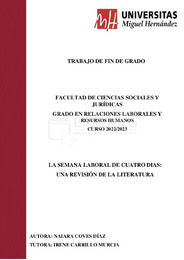Por favor, use este identificador para citar o enlazar este ítem:
https://hdl.handle.net/11000/30438Registro completo de metadatos
| Campo DC | Valor | Lengua/Idioma |
|---|---|---|
| dc.contributor.advisor | Carrillo Murcia, Irene | - |
| dc.contributor.author | Coves Díaz, Naiara | - |
| dc.contributor.other | Departamentos de la UMH::Ciencias Sociales y Humanas | es_ES |
| dc.date.accessioned | 2023-12-22T12:45:57Z | - |
| dc.date.available | 2023-12-22T12:45:57Z | - |
| dc.date.created | 2023-09 | - |
| dc.identifier.uri | https://hdl.handle.net/11000/30438 | - |
| dc.description.abstract | En los últimos años, las empresas se han visto obligadas a adaptarse al entorno tan cambiante y competitivo que existe hoy en día, para poder sobrevivir y seguir creciendo. Dicho entorno se vio bastante más afectado aún, con la llegada de la pandemia por COVID-19, por lo que las empresas tuvieron que adaptarse y hacer bastantes cambios para poder mantenerse en el mercado. Para poder hacer frente a esta situación, las empresas tuvieron que adoptar diversas medidas, desde mantener cerrados sus negocios durante un tiempo por no poder afrontar económicamente el coste de los cambios que suponía la llegada del virus, hasta incorporar nuevas modalidades de trabajo como el teletrabajo, que se basa en desempeñar la jornada laboral en un lugar distinto al habitual de la empresa. Esta situación provocó una búsqueda de mayor flexibilidad y comodidad, principalmente por parte de los trabajadores, para permitirles poder mantener la conciliación laboral y familiar que habían ganado gracias a las medidas adoptadas durante la pandemia. Es por ello que la jornada laboral de cuatro días a la semana se encuentra en su momento más sublime. Esta organización laboral de cuatro días semanales surgió, a partir de los años ochenta, por la necesidad de proporcionar empleo a la mayor cantidad de personas posible, debido a la elevada tasa de desempleo. Actualmente, la incorporación de esta jornada laboral pretende lograr el objetivo de alcanzar el equilibrio entre el trabajo y la vida personal, y lograr un bienestar de las personas. | es_ES |
| dc.description.abstract | In recent years, companies have been forced to adapt to the changing and competitive environment that exists today, to be able to survive and continue expanding. That environment has been even more affected with the arrival of the COVID-19 pandemic, because the companies had to adapt and made too much changes to be able to stay in the market. To be able to face this situation, companies had to adopt different measures, from keeping their businesses closed for a while because they could not afford the cost of the changes brought about by the arrival of the virus, to incorporate new working modalities as teleworking, which is based on performing the working day in a place other than the usual one of the company. This situation provoked a search for greater flexibility and comfort, mainly on the part of the workers, to let them be able to keep the work-life balance they had gained thanks to the measures adopted during the pandemic. That is why the four-day-a-week workday is at its most sublime. This labour organization of four days a week emerged from the eighties, by the need to provide employment to as many people as possible, due to the high unemployment rate. Currently, the incorporation of this working day is to achieve the goal of achieving balance between work and personal life, and achieve people’s well-being. | es_ES |
| dc.format | application/pdf | es_ES |
| dc.format.extent | 50 | es_ES |
| dc.language.iso | spa | es_ES |
| dc.publisher | Universidad Miguel Hernández de Elche | es_ES |
| dc.rights | info:eu-repo/semantics/openAccess | es_ES |
| dc.rights | Attribution-NonCommercial-NoDerivatives 4.0 Internacional | * |
| dc.rights.uri | http://creativecommons.org/licenses/by-nc-nd/4.0/ | * |
| dc.subject | Jornada laboral | es_ES |
| dc.subject | cuatro días | es_ES |
| dc.subject | productivida | es_ES |
| dc.subject | riesgos psicosociales | es_ES |
| dc.subject | Working hours | es_ES |
| dc.subject | four-day working days, | es_ES |
| dc.subject | productivity | es_ES |
| dc.subject | psychosocial risks | es_ES |
| dc.subject.other | CDU::3 - Ciencias sociales::33 - Economía::331 - Trabajo. Relaciones laborales. Ocupación. Organización del trabajo | es_ES |
| dc.title | La semana laboral del cuatro días: una revisión de la literatura | es_ES |
| dc.type | info:eu-repo/semantics/bachelorThesis | es_ES |

Ver/Abrir:
RLA_TFG_Naiara Coves Díaz.pdf
1,32 MB
Adobe PDF
Compartir:
 La licencia se describe como: Atribución-NonComercial-NoDerivada 4.0 Internacional.
La licencia se describe como: Atribución-NonComercial-NoDerivada 4.0 Internacional.
.png)